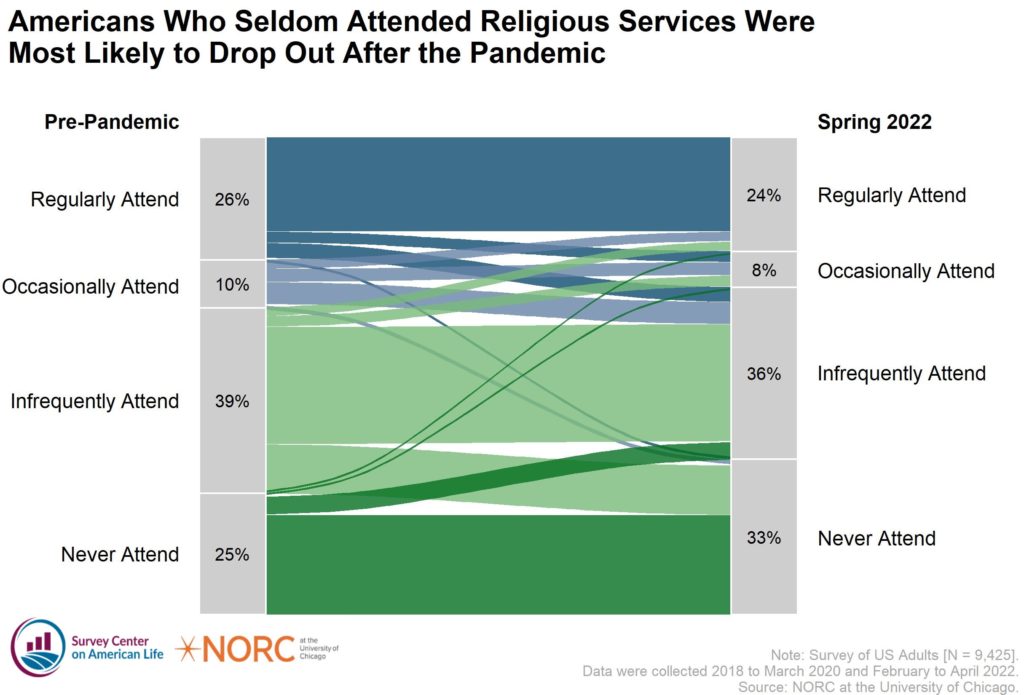
While religious identity has remained stable in post-pandemic America, a new study finds that there have been significant losses in religious attendance. The 2022 American Religious Benchmark Survey, conducted by the American Enterprise Institute and the University of Chicago’s National Opinion Research Center, compared religious affiliation and attendance data before the pandemic (from 2018 to March 2020) and in the spring of 2022. Interviews were conducted with the same people in 2022 in order to measure actual changes. The results show that religious identity remained stable through the pandemic. White mainline Christians and white evangelical Christians were the two largest religious groups both pre-pandemic and in spring 2022. Unaffiliated adults also made up a quarter of adults in both periods. However, religious attendance was significantly lower in spring 2022 than it was pre-pandemic. In spring 2022, 33 percent of Americans reported that they never attended religious services, compared to one in four who reported this before the pandemic. There was less change among highly religiously engaged Americans. Before the pandemic, 26 percent of Americans reported attending religious services at least once a week, similar to the 24 percent who did so in spring 2022.

The survey also shows who remained in, returned to, and left the pews. Conservatives, adults aged 50 and older, women, married adults, and those with a college degree were more likely to attend congregations in both periods than were other groups. Most adults kept their attendance at the same rate as pre-pandemic, including those 65 and older, adults with a college degree or higher, Mormon adults, white evangelical Christians, and white Catholics. Adults aged 30 to 49, adults with less than a college degree, and black Protestants saw the largest increases in attendance between these two periods. Twice as many adults decreased attendance as increased attendance, however. Hispanic Catholics and white mainline Protestants saw the largest declines in attendance. The study concludes that at least in terms of religious attendance, the pandemic convinced those who had the weakest commitments to regular attendance to exit their congregations for good. The decline of religious attendance and the stability of religious identity over the past two years suggest a decoupling of religious identity and experience.
(The report can be downloaded from: https://www.aei.org/wp-content/uploads/2023/01/Faith-After-the-Pandemic.pdf?x91208)

Source: Expats Poland.
The diocese with the highest percentage of dominicantes and communicantes in 2021 was Tarnów, in southeastern Poland, with 59.1 percent and 21.9 percent respectively, while Szczecin-Kamień archdiocese, in northwestern Poland, recorded just 16.9 percent and 8.1 percent respectively. While controversies over abortion and the clerical sex abuse crisis are cited as factors in the declines, the coronavirus pandemic is seen as the most significant factor. The new report notes that on the day the statistics were collected, Poland’s Covid-19 restrictions were in place. Social distancing measures meant that Mass-goers were permitted to occupy only half of all seats in churches (a limitation that did not apply to people fully vaccinated) and they were also obliged to wear masks. In remarks quoted by the Polish Press Agency, ISKK’s deputy director Marcin Jewdokimow said: “In previous years, the declines in the dominicantes index were constant. This time we’re dealing with a collapse. Therefore, I believe that next year we will have a rebound, the statistics will show an increase.”